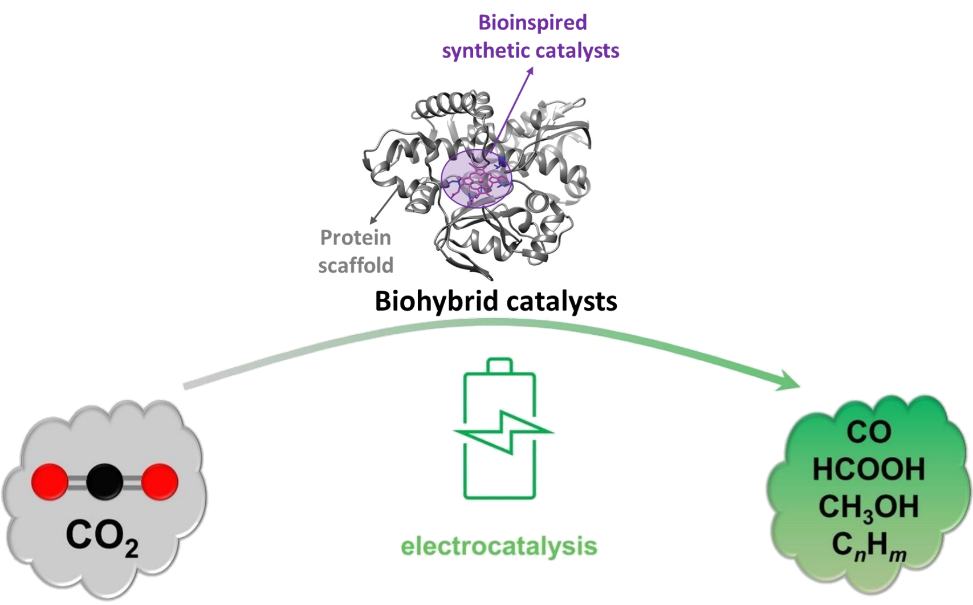Carbon dioxide (CO2) is a major greenhouse gas produced mostly from fossil fuel combustion. Accumulation of high levels of CO2 in the atmosphere directly contributes to climate change and global warming, and is one of the most concerning problems that society is facing. Nevertheless, atmospheric CO2 is also an abundant and inexpensive carbon feedstock. Thus, converting CO2 into other carbon feedstocks (e.g., CO) and high-value chemicals (e.g., formate, methanol, ethanol) offers solutions for both mitigating climate change and producing valuable carbon-based products. The CO2 molecule is very stable and inert and therefore, its reduction into other carbon compounds is very challenging.
Nature has evolved over billion of years to meet these challenges by facilitating the fixation of CO2 from the atmosphere and its conversion into essential metabolites for the survival and function of some microorganisms. To date, only four enzymes that can directly reduce CO2 from the atmosphere have been discovered and characterise, from which carbon monoxide dehydrogenases (CODHs) and formate dehydrogenases (FDH) are probably the best characterised.
Inspired by these native enzymes, this project aims to design biohybrid catalysts to mimic the functions of native CO2-reducing enzymes using alternative proteins scaffolds containing bioinspired synthetic catalysts.
The project will encompass three main stages. Stage 1 will focus on investigating the CO2 reduction electrocatalytic activity of a range of bioinspired synthetic catalysts which have been developed and already synthesised by the second supervisor, Dr Sandy Kilpatrick, group. In Stage 2, small and easy to produce protein scaffolds, such as myoglobin (Mb) and cytochromes will be produced and engineered to mimic the active-site architecture of native CODH enzymes. In Stage 3, the bioinspired synthetic catalysts will be encapsulated into the produced protein scaffolds and the electrocatalytic activity of the biohybrid systems towards CO2 reduction will be investigated. Overall, this project will develop new approaches for environmental biotechnology to fix greenhouse gases from the atmosphere and for CCU by building biohybrid catalysts inspired by native CO2-reducing enzymes.
Figure 1: Schematic showing the main aim of the project – to develop biohybrid catalysts (consisting of a bioinspired synthetic catalyst embedded within a natural protein scaffold) inspired by native CO2fixing enzymes, to convert CO2 into valuable carbon-based products using electrocatalysis. The final goal is to develop new approaches for environmental biotechnology to address the urgent climate crisis

This project is not suitable for CASE funding
Each host has a slightly different application process.
Find out how to apply for this studentship.
All applications must include the CENTA application form.
Choose your application route
The research plan breaks down as follows: 1) Characterisation of the bioinspired catalysts and investigation of their reactivity towards CO2 under different conditions. 2) Heterologous expression (e.g., inside E. coli) and purification of the protein scaffolds. The project will start with sperm whale Mb to then explore cytochromes from different organism. 3) In parallel with step 2, bioinformatic analysis of the selected protein scaffolds and native CO2-reducing enzymes (i.e., CODHs and FDH) will be done to engineer the Mb and cytochrome scaffolds to design active-site mutants that mimic the active-site cavity of native CO2-reduction enzymes. 4) The bioinspired synthetic catalysts investigated in step 1 will be encapsulated inside the produced and engineered protein scaffolds to generate a set of biohybrid catalysts. 5) The structure–function of the biohybrid catalysts will be studied via an integrated approach combining electrochemical, spectroscopic, structural and computational methods, and their reactivity towards CO2-reduction will be explored.
DRs will be awarded CENTA Training Credits (CTCs) for participation in CENTA-provided and ‘free choice’ external training. One CTC can be earned per 3 hours training, and DRs must accrue 100 CTCs across the three and a half years of their PhD.
The student will benefit from this highly multidisciplinary project co-supervised by Rodriguez-Macia and Kilpatrick. The student will acquire crucial lab-based and interpersonal skills from the supervisory team and their research group members. They will be trained in molecular biology, reconstitution strategies, structural biology, spectroscopy, electrochemistry and synthetic chemistry.
The student will also be able to attend various modules available in the Chemistry degree, e.g. Earth System Science by Dr Ball, and Advanced Structure Determination by the PIs Dr Rodriguez-Macia and Dr Kilpatrick.
The supervisors will encourage participation at conferences and outreach activities.
Year 1: Characterisation of the bioinspired catalysts and investigation of their reactivity towards CO2 under different conditions, and heterologous expression (e.g., inside E. coli) and purification of sperm whale Mb.
Year 2: Identify suitable cytochrome proteins and produce them in the lab. Bioinformatic analysis of the selected protein scaffolds and native CO2-reducing enzymes to design active-site mutants based on the active-site architecture of native CO2-reduction enzymes.
Year 3: Encapsulation of the bioinspired synthetic catalysts within the produced protein scaffolds and investigation of their reactivity towards CO2. Write a paper/s with the student as first named author.
Davis S.J., Caldeira K., Matthews H.D. (2010) ‘Future CO2 emissions and climate change from existing energy infrastructure’, Science, 329, pp. 1330-1333.
Goeppert A., Czaun M., Prakash G.K.S., Olah G.A. (2012) ‘Air as the renewable carbon source of the future: an overview of CO2 capture from the atmosphere’, Energy Environ. Sci., 5, pp. 7833-7853.
Ünlü A., Duman-Özdamar Z.E., Çaloğlu B., Binay B. (2021) ‘Enzymes for efficient CO2 conversion’, Protein J., 40, pp. 489-503.
Deng Y., Wang J.-X., Ghosh B., Lu Y. (2024) ‘Enzymatic CO2 reduction catalyzed by natural and artificial Metalloenzymes’, J. Inorg. Biochem., 259, pp. 112669
Potential applicants are welcome to discuss the project informally with the project supervisors: Dr Patricia Rodriguez Macia (email: [email protected]) and Dr Sandy Kilpatrick (email: a[email protected])
More information about the supervisory team and the School of Chemistry at the University of Leicester can be found here: https://le.ac.uk/chemistry; https://www.rodriguezmacialab.com/; https://www.kilpatrickgroup.uk/
To apply to this project:
Applications must be submitted by 23:59 GMT on Wednesday 7th January 2026.